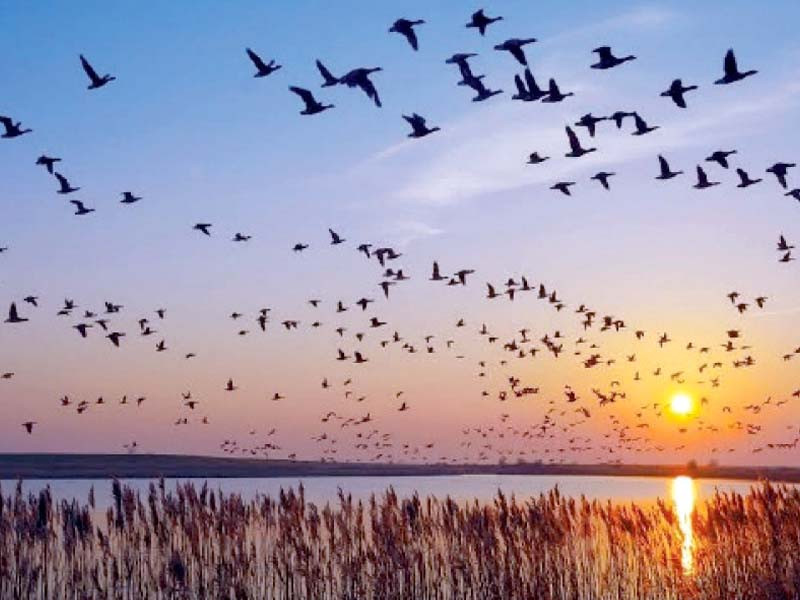
Migratory birds from Siberia and other extremely cold regions in the north spend winters in the mild climate of Sindh.
The contentious practice of legal hunting serves the dual interests of both the government, which earns substantial revenue through the issuance of licenses and the hunters, who get to pursue their seasonal hobby; however for the endangered migratory bird population facing the arrow, the practice only pushes them one step further towards extinction.
Every year a large flock of migratory Siberian birds fly thousands of miles from the permafrost regions of Russia in search for food and water before settling across various areas in Pakistan.
These birds, which include various types of Demoiselle crane, Bhagosh, Charu, Chiklu, Banaro, little ducks and red heads among others, have been declining in numbers over the past few years due to excessive hunting activities after the legalization of the practice by Punjab Wildlife for a duration of six months from October 1st to March 31st.
Thousands of hunters continue to kill rare species of birds for recreational purposes every year during the winter season, at a time when climate change has already reduced the life span of numerous bird populations by altering their optimum survival conditions.
According to the Red List of Threatened Species circulated by the International Union for Conservation of Nature, almost 5,412 species of birds have decreased in numbers during the past 30 years worldwide, in comparison to the miniscule growth in population size of only 659 species.
“Climate change, water scarcity and pollution have already diminished bird populations across the globe. But in Pakistan the problem is much worse due to excessive hunting. Almost 380 species of migratory birds exist in our country, but these numbers are going down each year,” said Dr Zulfiqar Ali, Head of the Department of Biology at the University of Punjab.
Agreeing with Dr Ali on the pitfalls of legalized hunting, Fahad Malik, Head of the Mission Awareness Foundation, felt that hunting should be completely banned nowadays since all kinds of meat is readily available at the marketplace. “When a hunter goes hunting with his friends, sporting a gun in his hands, he considers it humiliating to return home without a kill. The strong fervor to catch prey acts as an ego boost, blinding him to the suffering of the birds, whose entire populations are being annihilated,” resented Malik.
M Ramzan, Assistant Director of the Publicity Department of Punjab Wildlife, was of the opinion that legalised hunting was a solid means of revenue generation for the provincial government and was hence beneficial. “The license fee per hunter is Rs 2,300, and in the preceding year the department earned approximately Rs 69 million by issuing licenses. Hunting is allowed only for two days, Saturday’s and Sunday’s of each week during the season. Furthermore, a hunter can hunt a maximum of ten birds in designated areas only which exclude protected areas, wildlife sanctuaries and national parks. No hunting is allowed during the breeding season from April to September.
Autumn marks the arrival of migratory birds from the Siberian region and the hunting season’s opening. Waterfowl, such as mallards, teals, herons, and geese, fly thousands of kilometers to the mild environs of Sindh and other areas ofSouth Asia.
Game hunting under permit is an international practice and a source of revenue for the Sindh Wildlife Department. However, excessive killing of the game birds as well as illegal hunting or poaching remains a challenge for the government and a source of concern for the sportsmen.
The Sindh Wildlife Department opens the hunting season for partridges and waterfowl for four months – from November to February. Hunters require a permit, allowing for the harvest of up to 15 ducks or any other waterfowl and 10 partridges or any other pheasant per license.
The lifting of the hunting ban coincides with the start of the non-breeding season in Sindh, during which nesting and young birds are not present. The officially sanctioned season ensures that hunting is confined to weekends. However, hunting is strictly prohibited in Kirthar National Park, all wildlife sanctuaries, and cantonment areas.
The Sindh Wildlife Department has declared a wildlife emergency for the duration of the hunting season. Wildlife officials are tasked with patrolling their jurisdictions to enforce regulation, with support from police, Rangers, and other law enforcement agencies.
For the first time, police and various local authorities, including magistrates and local body officials, have the authority to check hunting permits and ensure compliance with bag limits (number of hunted birds per permit). This initiative, according to Sindh Wildlife Department’s Chief Conservator Javed Mahar, aims to ensure transparency and curb illegal hunting practices.
Foreign visitors can acquire hunting permits for a fee of $100, separate from local hunters. The Sindh Wildlife Department staff, including field officers and inspectors, will conduct routine patrols to enforce wildlife laws.
Sindh is home to over 380 species of birds, including popular game species such as brown partridge, black partridge, and various waterfowl that migrate from Siberian region to benefit from the province’s moderate climate in autumn, spend the winter here, and return at the advent of spring.
